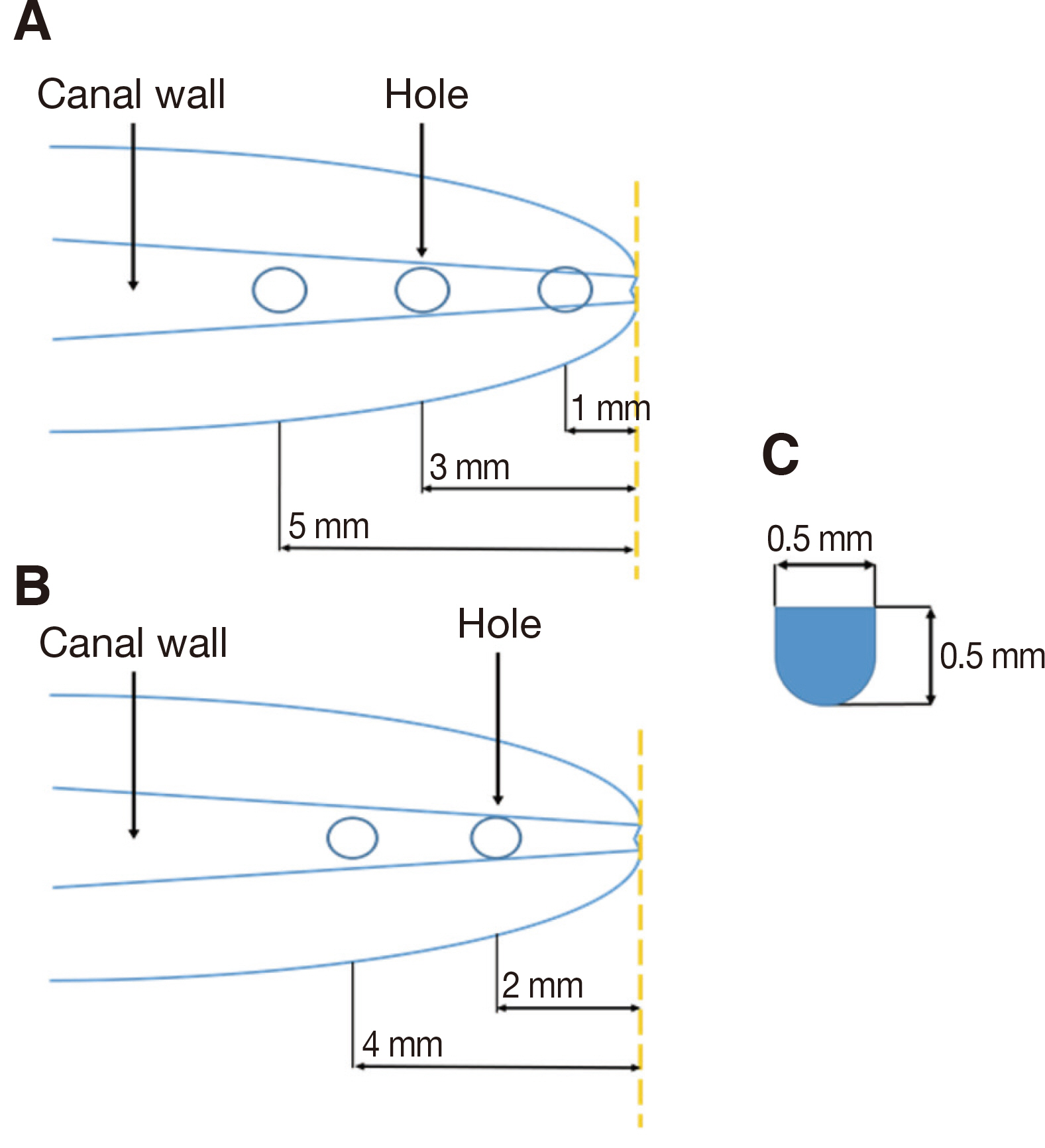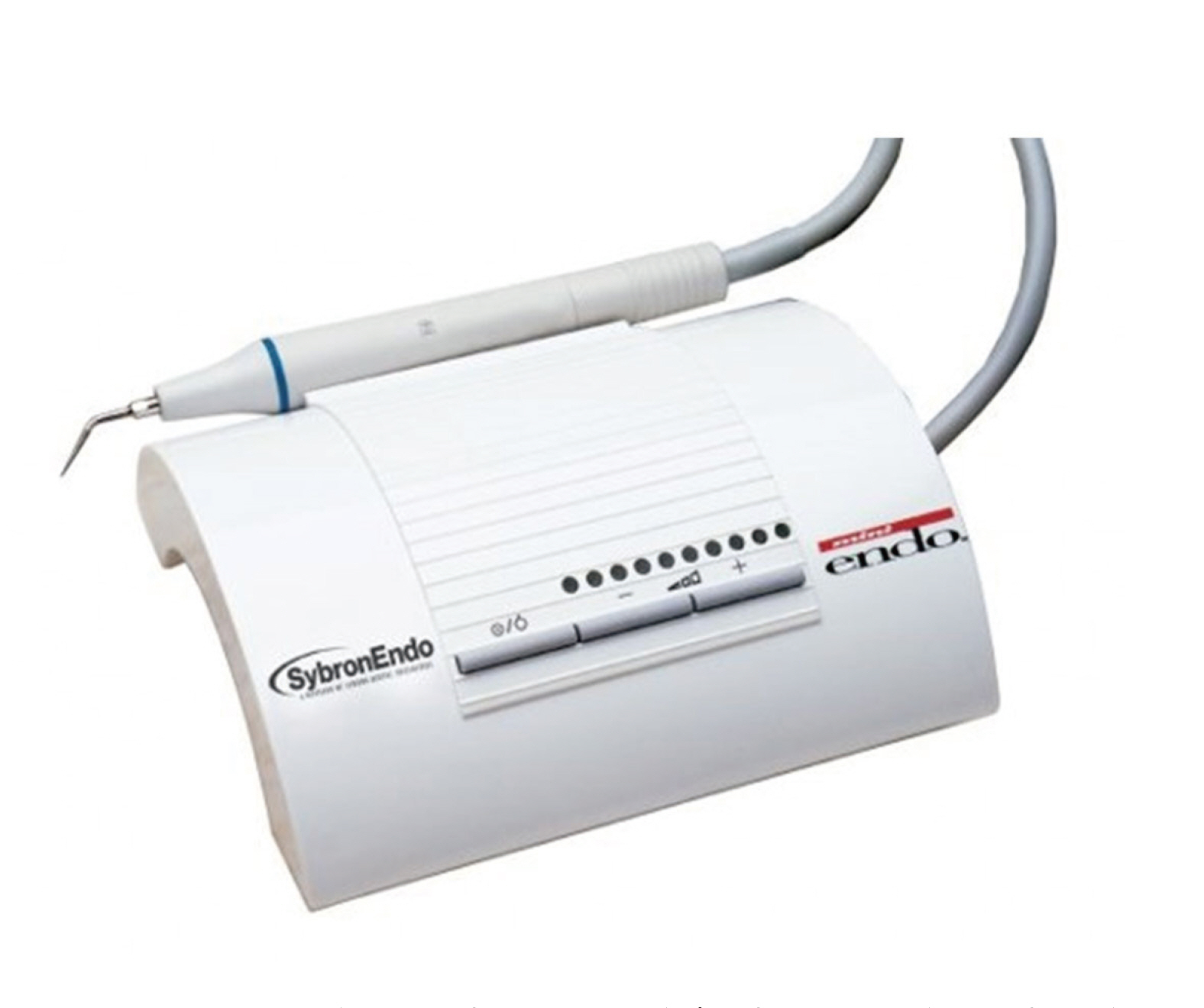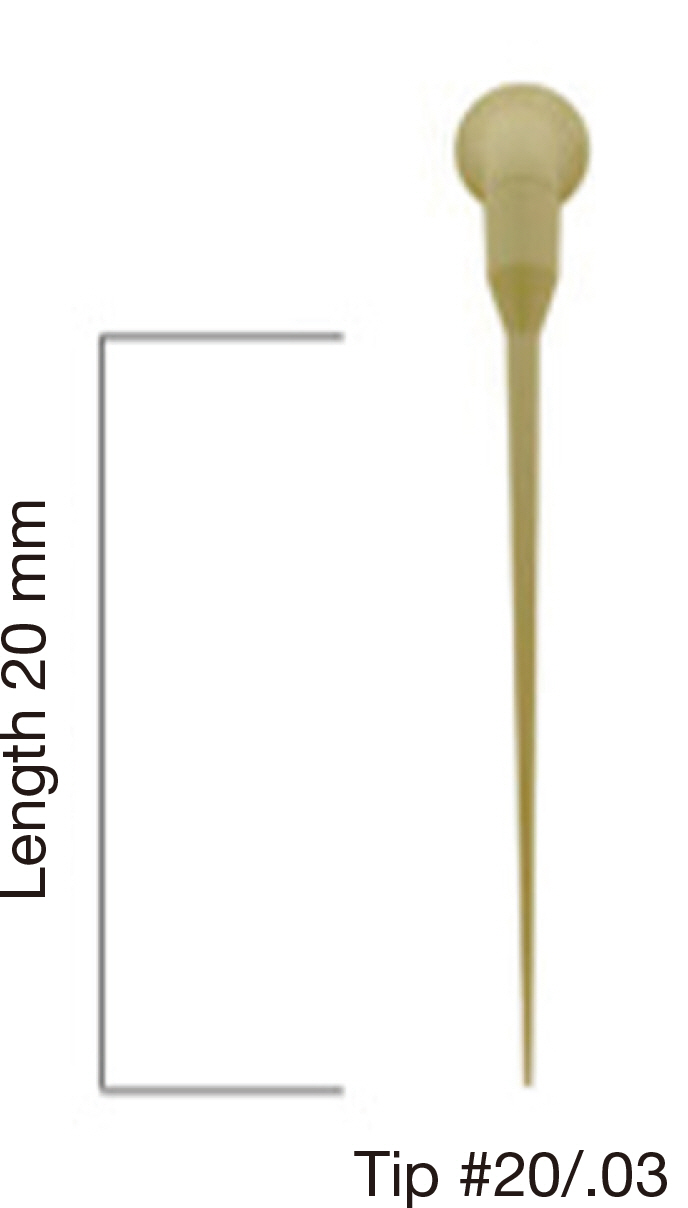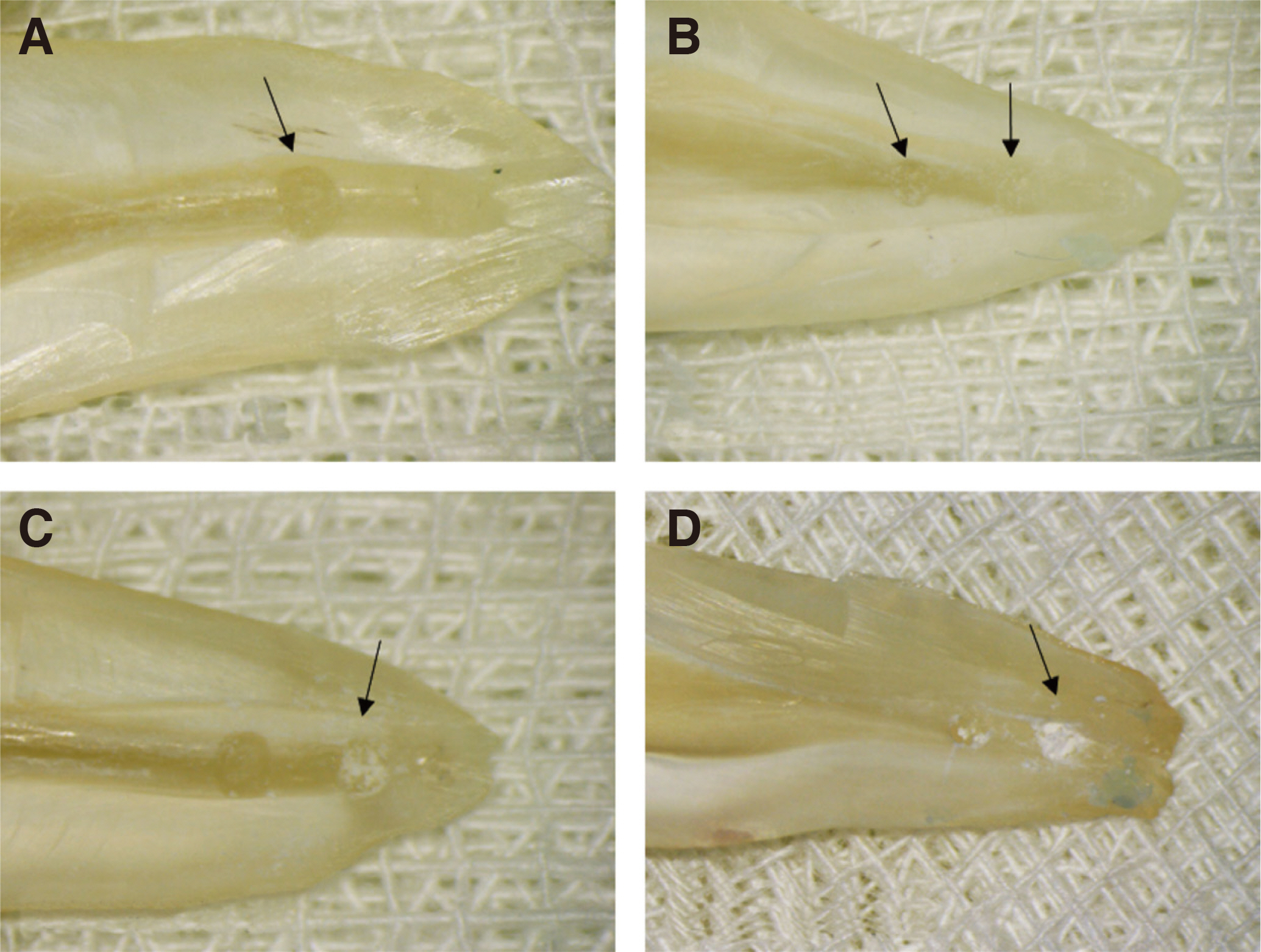J Dent Rehabil Appl Sci.
2020 Jun;36(2):104-111. 10.14368/jdras.2020.36.2.104.
Debris removal efficiency depend on different ultrasonic irrigation protocols
- Affiliations
-
- 1Department of Conservative Dentistry, College of Dentistry, Gangneung-Wonju National University, Gangneung, Republic of Korea
- 2School of Dentistry, Mongolian National University of Medical Sciences, Ulaanbaatar, Mongolia
- 3Division of Conservative Dentistry, Department of Dentistry, College of Medicine, Hanyang University, Seoul, Republic of Korea
- KMID: 2503806
- DOI: http://doi.org/10.14368/jdras.2020.36.2.104
Abstract
- Purpose
The purpose of this study is comparing the efficiency of debris removal of passive ultrasonic irrigation depend on different protocols.
Materials and Methods
Forty-eight mandibular premolars were randomly divided into 2 groups depend on vibration power (Weak and Strong, n = 24). And then two groups were subdivided into 3 groups depend on the number of times that PUI used (1, 2 and 3, n = 8). After standardization, teeth were split into two halves. On the wall of one half of root canal, three depressions were cut at 1, 3 and 5 mm from the apex and in the same way two depressions were cut on the other half of root canal at 2, 4 mm from the apex. Each depression was filled with mixture of dentine and NaOCl. After irrigation, images of the root canal wall were taken, and then the amount of remaining dentine debris was evaluated.
Results
There was no significant difference between weak and strong power of vibration groups. Weak vibration groups did not show significant difference depend on the different number of times PUI used. But in the strong vibration groups, twice and three times used groups show better removal efficiency.
Conclusion
The removal efficiency of dentine debris is not significantly different depend on the power of vibration. And multiple use of PUI could have better irrigating effects at the apical third area in the strong vibration group.
Keyword
Figure
Reference
-
References
1. Haapasalo M, Endal U, Zandi H, Coil JM. 2005; Eradication of endodontic infection by instrumentation and irrigation solutions. Endod Topics. 10:77–102. DOI: 10.1111/j.1601-1546.2005.00135.x.2. Schilder H. 1974; Cleaning and shaping the root canal. Dent Clin North Am. 18:269–96.3. Peters OA, Peters CI, Schönenberger K, Barbakow F. 2003; ProTaper rotary root canal preparation: effects of canal anatomy on final shape analysed by micro CT. Int Endod J. 36:86–92. DOI: 10.1046/j.1365-2591.2003.00626.x. PMID: 12657151.4. Weiger R, Elayouti A, Löst C. 2002; Efficiency of Hand and Rotary Instruments in Shaping Oval Root Canals. J Endod. 28:580–3. DOI: 10.1097/00004770-200208000-00004. PMID: 12184418.5. Peters OA, Schönenberger K, Laib A. 2001; Effects of four Ni-Ti preparation techniques on root canal geometry assessed by micro computed tomography. Int Endod J. 34:221–30. DOI: 10.1046/j.1365-2591.2001.00373.x. PMID: 12193268.6. Siqueira JF Jr, Rôças IN, Santos SR, Lima KC, Magalhães FA, de Uzeda M. 2002; Efficacy of instrumentation techniques and irrigation regimens in reducing the bacterial population within root canals. J Endod. 28:181–4. DOI: 10.1097/00004770-200203000-00009. PMID: 12017176.7. Boutsioukis C, Lambrianidis T, Kastrinakis E. 2009; Irrigant flow within a prepared root canal using various flow rates: a computational fluid dynamics study. Int Endod J. 42:144–55. DOI: 10.1111/j.1365-2591.2008.01503.x. PMID: 19134043.8. Zehnder M. 2006; Root canal irrigants. J Endod. 32:389–98. DOI: 10.1016/j.joen.2005.09.014. PMID: 16631834.9. Abou-Rass M, Piccinino MV. 1982; The effectiveness of four clinical irrigation methods on the removal of root canal debris. Oral Surg Oral Med Oral Pathol. 54:323–8. DOI: 10.1016/0030-4220(82)90103-7.10. Chow TW. 1983; Mechanical effectiveness of root canal irrigation. J Endod. 9:475–9. DOI: 10.1016/S0099-2399(83)80162-9. PMID: 6586975.11. Weller RN, Brady JM, Bernier WE. 1980; Efficacy of ultrasonic cleaning. J Endod. 6:740–3. DOI: 10.1016/S0099-2399(80)80185-3. PMID: 6935384.12. Lee SJ, Wu MK, Wesselink PR. 2004; The effectiveness of syringe irrigation and ultrasonics to remove debris from simulated irregularities within prepared root canal walls. Int Endod J. 37:672–8. DOI: 10.1111/j.1365-2591.2004.00848.x. PMID: 15347291.13. Al-Jadaa A, Paqué F, Attin T, Zehnder M. 2009; Necrotic pulp tissue dissolution by passive ultrasonic irrigation in simulated accessory canals: impact of canal location and angulation. Int Endod J. 42:59–65. DOI: 10.1111/j.1365-2591.2008.01497.x. PMID: 19125981.14. de Gregorio C, Estevez R, Cisneros R, Paranjpe A, Cohenca N. 2010; Efficacy of different irrigation and activation systems on the penetration of sodium hypochlorite into simulated lateral canals and up to working length: an in vitro study. J Endod. 36:1216–21. DOI: 10.1016/j.joen.2010.02.019. PMID: 20630302.15. van der Sluis LW, Versluis M, Wu MK, Wesselink PR. 2007; Passive ultrasonic irrigation of the root canal: a review of the literature. Int Endod J. 40:415–26. DOI: 10.1111/j.1365-2591.2007.01243.x. PMID: 17442017.16. Krell KV, Johnson RJ. 1988; Irrigation patterns of ultrasonic endodontic files. Part II. Diamond-coated files. J Endod. 14:535–7. DOI: 10.1016/S0099-2399(88)80085-2. PMID: 3249189.17. van der Sluis LWM, Wu MK, Wesselink PR. 2005; The efficacy of ultrasonic irrigation to remove artificially placed dentine debris from human root canals prepared using instruments of varying taper. Int Endod J. 38:764–8. DOI: 10.1111/j.1365-2591.2005.01018.x. PMID: 16164691.18. Hülsmann M, Schade M, Schäfers F. 2001; A comparative study of root canal preparation with HERO 642 and Quantec SC rotary Ni-Ti instruments. Int Endod J. 34:538–46. DOI: 10.1046/j.1365-2591.2001.00431.x. PMID: 11601772.19. Ardila CN, Wu MK, Wesselink PR. 2003; Percentage of filled canal area in mandibular molars after conventional root-canal instrumentation and after a noninstrumentation technique (NIT). Int Endod J. 36:591–8. DOI: 10.1046/j.1365-2591.2003.00689.x. PMID: 12950572.20. De-Deus G, Barino B, Zamolyi RQ, Souza E, Fonseca A Jr, Fidel S, Fidel RA. 2010; Suboptimal debridement quality produced by the single-file F2 ProTaper technique in oval-shaped canals. J Endod. 36:1897–900. DOI: 10.1016/j.joen.2010.08.009. PMID: 20951309.21. Căpută PE, Retsas A, Kuijk L, Chávez de Paz LE, Boutsioukis C. 2019; Ultrasonic irrigant activation during root canal treatment: A systematic review. J Endod. 45:31–44.e13. DOI: 10.1016/j.joen.2018.09.010. PMID: 30558797.22. Jiang LM, Verhaagen B, Versluis M, Langedijk J, Wesselink P, van der Sluis LW. 2011; The influence of the ultrasonic intensity on the cleaning efficacy of passive ultrasonic irrigation. J Endod. 37:688–92. DOI: 10.1016/j.joen.2011.02.004. PMID: 21496672.23. Macedo R, Verhaagen B, Rivas DF, Versluis M, Wesselink P, van der Sluis L. 2014; Cavitation measurement during sonic and ultrasonic activated irrigation. J Endod. 40:580–3. DOI: 10.1016/j.joen.2013.09.018. PMID: 24666916.24. Verhaagen B, Boutsioukis C, Heijnen GL, van der Sluis LWM, Versluis M. 2012; Role of the confinement of a root canal on jet impingement during endodontic irrigation. Experiments in Fluids. 53:1841–53. DOI: 10.1007/s00348-012-1395-0.25. Macedo RG, Robinson JP, Verhaagen B, Walmsley AD, Versluis M, Cooper PR, van der Sluis LW. 2014; A novel methodology providing insights into removal of biofilm-mimicking hydrogel from lateral morphological features of the root canal during irrigation procedures. Int Endod J. 47:1040–51. DOI: 10.1111/iej.12246. PMID: 24397845.26. Boutsioukis C, Kastrinakis E, Lambrianidis T, Verhaagen B, Versluis M, van der Sluis LW. 2014; Formation and removal of apical vapor lock during syringe irrigation: a combined experimental and Computational Fluid Dynamics approach. Int Endod J. 47:191–201. DOI: 10.1111/iej.12133. PMID: 23711027.27. Robinson JP, Macedo RG, Verhaagen B, Versluis M, Cooper PR, van der Sluis LWM, Walmsley AD. 2018; Cleaning lateral morphological features of the root canal: the role of streaming and cavitation. Int Endod J. 51(Suppl 1):e55–e64. DOI: 10.1111/iej.12804. PMID: 28654211.28. Cunningham WT, Balekjian AY. 1980; Effect of temperature on collagen-dissolving ability of sodium hypochlorite endodontic irrigant. Oral Surg Oral Med Oral Pathol. 49:175–7. DOI: 10.1016/0030-4220(80)90313-8. PMID: 6928291.29. Abou-Rass M, Oglesby SW. 1981; The effects of temperature, concentration, and tissue type on the solvent ability of sodium hypochlorite. J Endod. 7:376–7. DOI: 10.1016/S0099-2399(81)80059-3.
- Full Text Links
- Actions
-
Cited
- CITED
-
- Close
- Share
- Similar articles
-
- The efficacy of ultrasonic irrigation technique on debris removal during root canal treatment
- Comparison of various activation methods of root canal irrigants for soft-tissue removal
- Effect of passive ultrasonic agitation during final irrigation on cleaning capacity of hybrid instrumentation
- Review of root canal irrigant delivery techniques and devices
- In vitro evaluation of cleaning efficacy of various irrigation methods in mandibular molars





